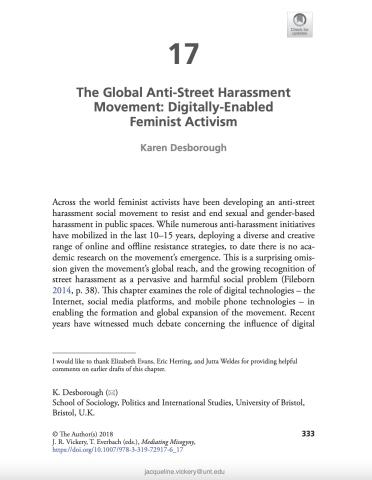
The Global Anti-Street Harassment Movement: Digitally-Enabled Feminist Activism

Across the world feminist activists have been developing an anti-street harassment social movement to resist and end sexual and gender-based harassment in public spaces. While numerous anti-harassment initiatives have mobilized in the last 10–15 years, deploying a diverse and creative range of online and ofine resistance strategies, to date there is no academic research on the movement’s emergence. Tis is a surprising omission given the movement’s global reach, and the growing recognition of street harassment as a pervasive and harmful social problem (Fileborn 2014, p. 38). Tis chapter examines the role of digital technologies – the Internet, social media platforms, and mobile phone technologies – in enabling the formation and global expansion of the movement. Recent years have witnessed much debate concerning the infuence of digital K. Desborough () School of Sociology, Politics and International Studies, University of Bristol, Bristol, U.K. I would like to thank Elizabeth Evans, Eric Herring, and Jutta Weldes for providing helpful comments on earlier drafts of this chapter. jacqueline.vickery@unt.edu 334 technologies on the emergence and outcomes of social movements (Shirky 2009; Gladwell 2010; Morozov 2011). Nevertheless, it is evident that such technologies do not determine social movements (Castells 2012, p. 103). Rather, digital technologies aford opportunities for activists organizing and participating in collective action. When technological afordances are leveraged efectively, social movements may emerge (Earl and Kimport 2011, p. 10). “Technological afordance” describes the “special technological capacities of Internet-enabled technologies’ and refers to the ‘actions or uses that a technology makes easier (and therefore facilitates)” (Earl and Kimport 2011, p. 32). Based on interviews with 32 anti-harassment activists, operative in ten countries,1 this chapter argues that activists have leveraged the afordances of digital technologies to organize and participate in anti-street harassment activism, thus accelerating the movement’s formation and development. Te chapter refers specifcally to 14 anti-street harassment initiatives (see Table 17.1). To structure my analysis, I draw on R. Kelly Garrett’s (2006) work on the mobilizing potential of digital technologies for collective action. Following a review of the social movement literature, Garrett identifed three technology-related mechanisms that can facilitate political participation. Digital technologies help to frst, reduce the costs of organizing and participating in collection action; second, promote collective identity, which helps to foster and maintain participation; and third, and relatedly, enable community formation (2006, p. 204).
Author: K. Desborough, School of Sociology, Politics and International Studies, University of Bristol, Bristol, U.K.